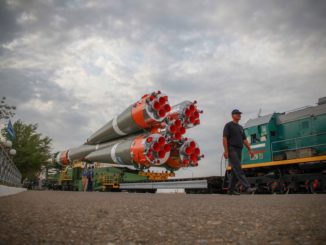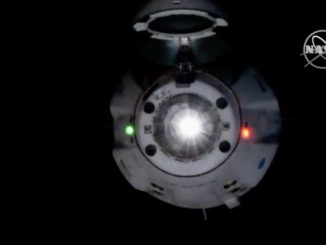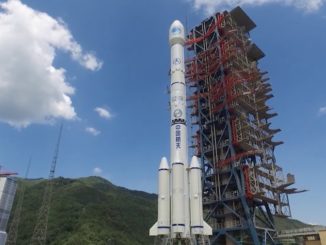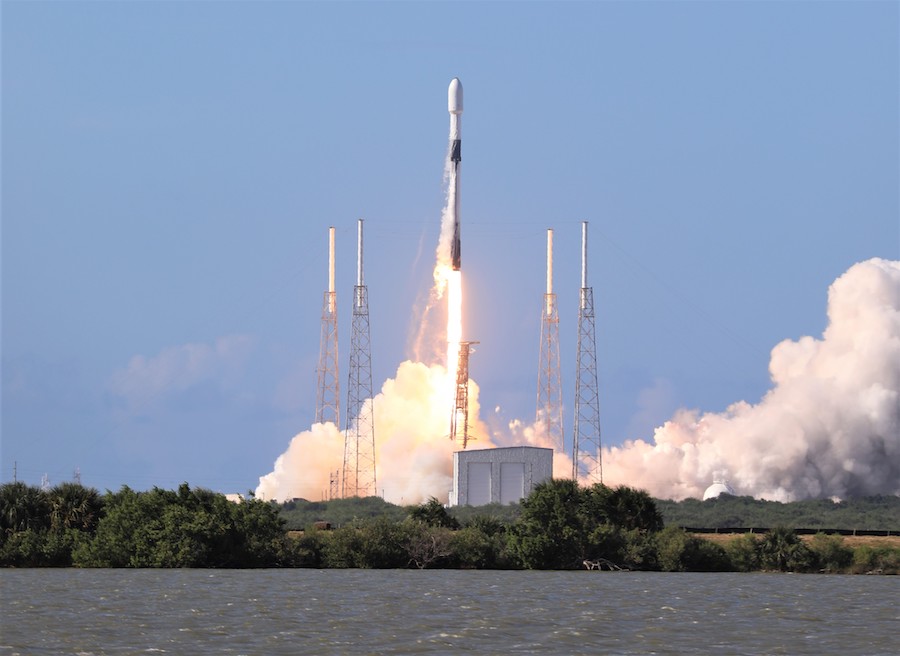
A SpaceX Falcon 9 rocket deployed South Korea’s first dedicated military satellite into orbit Monday a half-hour after a fiery launch from Cape Canaveral, helping fulfill an agreement between Lockheed Martin and the South Korean government in exchange for Korea’s purchase of F-35 fighter jets six years ago.
South Korea’s Anasis 2 military communications satellite rocketed away from Cape Canaveral at 5:30 p.m. EDT (2130 GMT) Monday on top of a Falcon 9 launcher. Nine Merlin main engines on the Falcon 9 rocket propelled the 229-foot-tall (70-meter) launcher off the ground, and the Falcon 9 turned east over the Atlantic Ocean, exceeding the speed of sound within about one minute.
Powered by the same first stage booster that launched astronauts May 30 on SpaceX’s Crew Dragon capsule, the Falcon 9 thundered into a sunny sky after a 30-minute delay Monday the company attributed to a passing rain shower.
The first stage shut down and separated from the Falcon 9’s second stage about two-and-a-half minutes after liftoff, beginning maneuvers to precisely touch down on SpaceX’s floating landing platform around 400 miles (645 kilometers) east of Cape Canaveral. The reusable first stage landed on target aboard the drone ship “Just Read The Instructions,” ready for return to Florida’s Space Coast for another flight.
The booster used on Monday’s launch set a record for the quickest turnaround time between flights of an orbital-class rocket stage at 51 days. The shortest span between launches of the same Falcon 9 booster was previously 62 days, which SpaceX achieved with a Feb. 17 mission.
NASA achieved a 54-day turnaround time between two launches of the space shuttle Atlantis in late 1985, a record never again matched during the 30-year-long shuttle program. The time elapsed between Atlantis’s landing and next launch was 50 days.
SpaceX may eclipse its rocket turnaround time record again in the coming weeks, with more missions on the company’s jam-packed launch schedule, all using reused rocket stages. The next brand new Falcon 9 booster is not expected to fly before late September.
SpaceX confirms a successful landing of the Falcon 9 rocket’s first stage on a drone ship in the Atlantic Ocean.
This is the same booster that previously launched SpaceX’s Crew Dragon spacecraft May 30 with astronauts Doug Hurley and Bob Behnken.
MORE: https://t.co/1vfSxib8EF pic.twitter.com/mRo3YBls3r
— Spaceflight Now (@SpaceflightNow) July 20, 2020
Meanwhile, SpaceX’s second stage engine ignited two times to inject the Anasis 2 spacecraft into an elliptical transfer orbit stretching thousands of miles above above Earth. The satellite will use its on-board engine to circularize its orbit more than 22,000 miles (nearly 36,000 kilometers) over the equator, where it will provide services for the South Korean military.
John Insprucker, a SpaceX engineer and manager who co-hosted the company’s launch webcast Monday, declared it a “totally successful mission.”
The Anasis 2 spacecraft was manufactured by Airbus Defense and Space in Toulouse, France, and is based on Airbus’s Eurostar E3000 satellite design.
Anasis 2 “will provide secured communications over wide coverage,” Airbus said in a statement.
South Korea procured the satellite — formerly known as KMilSatCom 1 — through an “offset” arrangement to offset South Korea’s purchase of F-35 fighter jets from Lockheed Martin. In exchange for South Korea’s purchase of 40 F-35 fighter jets — a deal reportedly valued at more than $6 billion — Lockheed Martin agreed to provide the Anasis 2 satellite to the South Korean military, among other offsets.
Lockheed Martin ultimately subcontracted the satellite manufacturing deal to Airbus, and booked launch services for Anasis 2 with SpaceX.
“Lockheed Martin is honored to deliver on the promise and commitment made to the Republic of Korea government with the successful launch of the Anasis 2 satellite,” Lockheed Martin said in a statement. “This launch and the expected in-orbit handover later this year are the first milestones signifying the completion of an offset project related to the sale of F-35s to the ROKG (Republic of Korea Government) in 2014.”
Before Anasis 2, South Korea’s military has relied on international and civilian-owned satellites for communications. A dual-use satellite named Anasis 1 launched in 2006 to provide commercial and military telecom services.
Further details about the Anasis 2 satellite are shrouded in secrecy at the wishes of the the spacecraft’s owner — the South Korean government. SpaceX did not broadcast live video of the Anasis 2 satellite deploying from the Falcon 9 rocket, citing a request from its customer.
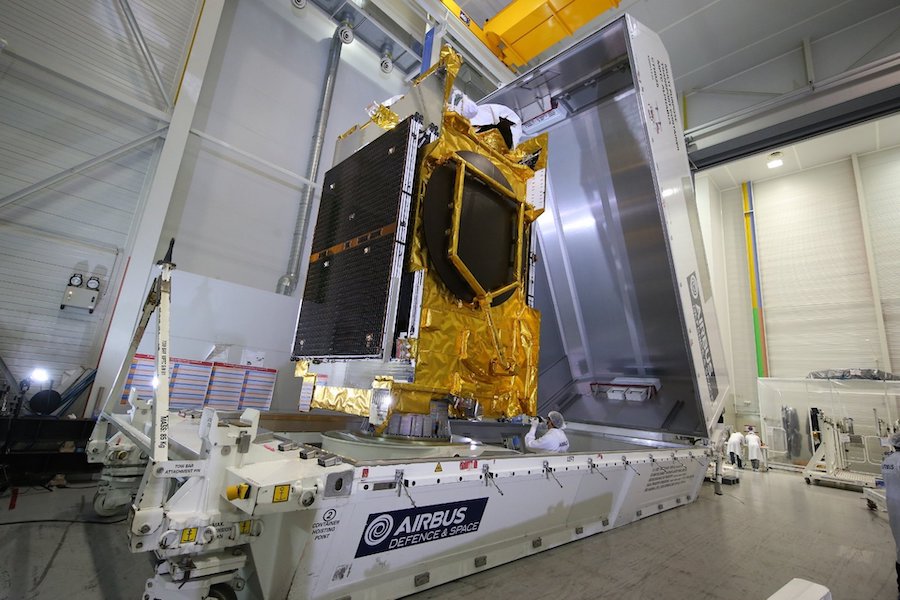
Elon Musk, SpaceX’s founder and CEO, tweeted later Monday that the company had successfully recovered both halves of the Falcon 9 rocket’s payload fairing using two boats stationed offshore in the Atlantic Ocean.
The twin fairing recovery vessels — named “Ms. Tree” and “Ms. Chief” — were dispatched to positions nearly 500 miles (800 kilometers) east of Cape Canaveral. Both ships are fitted with giant nets to try to catch the fairing halves, which descend under parachutes.
The Falcon 9 released the clamshell-like payload fairing around three-and-a-half minutes after liftoff Monday, once the rocket flew above the dense, lower layers of the atmosphere. The shroud protected the Anasis 2 satellite during the rocket’s initial climb away from Florida.
The successful fairing recovery marked the first time SpaceX achieved a double catch of both fairing halves on the same mission. On previous flights, SpaceX has either caught just one of the fairing shells, or retrieved them after splashing down in the ocean.
Monday’s mission was SpaceX’s 12th launch of the year, but it was the company’s first launch of 2020 dedicated to a customer other than NASA, the U.S. military, or SpaceX’s own Starlink Internet project.
Of SpaceX’s 11 previous missions this year, seven launched clusters of satellites for the company’s own Starlink broadband network. One of those missions carried a rideshare payload of three commercial SkySat Earth-observing satellites for Planet.
Three of SpaceX’s Falcon 9 missions so far in 2020 have been for NASA.
A Falcon 9 flight Jan. 19 launched a Crew Dragon capsule for a high-altitude test of the spaceship’s abort system. A Dragon cargo ship launched March 6 on a Falcon 9 rocket to resupply the International Space Station, and the first Crew Dragon flight with astronauts took off on a Falcon 9 rocket May 30.
SpaceX’s most recent launch before Monday delivered a GPS navigation satellite into orbit for the U.S. Space Force.
The market for large commercial geostationary satellites has experienced a downturn in the last few years, although there are signs that orders to build and launch geostationary communications spacecraft are on the uptick again.
SpaceX has another launch planned for an external foreign customer coming up later this month. Argentina’s SAOCOM 1B radar observation satellite is being prepared for launch at Cape Canaveral on a Falcon 9 rocket as soon as next week.
The launch of SAOCOM 1B was originally scheduled in March, but officials from CONAE — Argentina’s space agency — requested a delay in the launch due to travel and work restrictions related to the coronavirus pandemic. Using new physical distancing and safety protocols, crews returned to Cape Canaveral from Argentina earlier this month to resume preparations on the SAOCOM 1B satellite.
SpaceX also has several more Falcon 9 launches with Starlink satellites from Florida’s Space Coast in August. In September, SpaceX is gearing up for a launch with the next Crew Dragon spacecraft to carry astronauts to the space station, and another Falcon 9 flight with a GPS navigation satellite for the U.S. military.
Other missions on SpaceX’s manifest later this year — besides regularly-scheduled flights to add satellites to the Starlink Internet network — include Falcon 9 launches with a Dragon cargo craft to deliver supplies to the space station, commercial communications satellites for Turksat and SiriusXM, a joint U.S.-European oceanography satellite, and a rideshare mission carrying dozens of small satellites into polar orbit.
There is also a launch of a SpaceX Falcon Heavy rocket on the company’s schedule in late 2020. After taking off from the Kennedy Space Center, the heavy-lift rocket will deploy classified payloads into geostationary orbit for the U.S. Space Force.
Email the author.
Follow Stephen Clark on Twitter: @StephenClark1.

